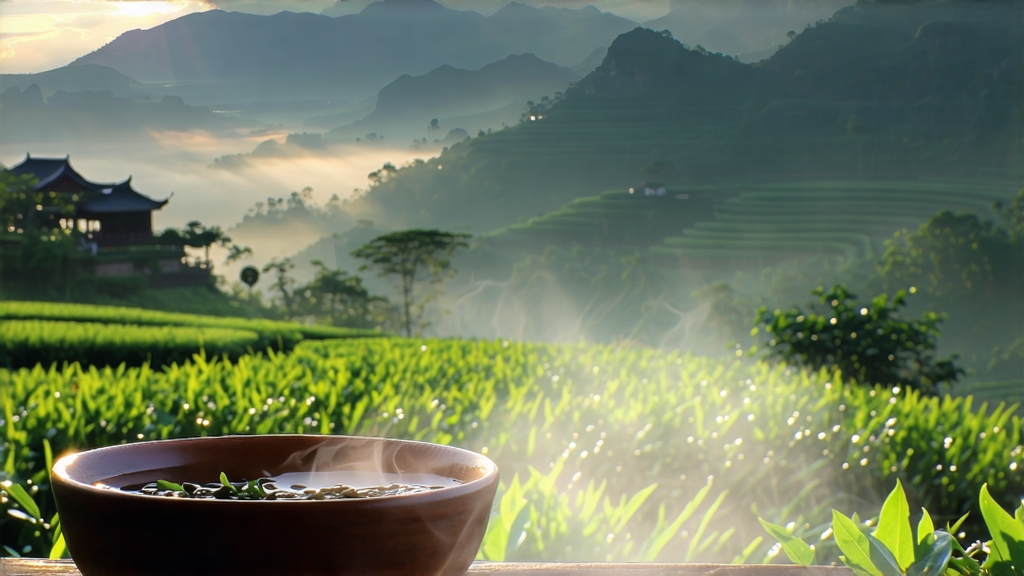
Alishan High-Mountain Oolong is not merely a tea; it is a sip of Taiwan’s sky. Grown between 1,000 and 1,400 metres in the Alishan range, this cultivar translates altitude into aroma, turning cool mists and short sunlit hours into a liquor that tastes of orchid, lilac and fresh cream. To understand why it has become the benchmark for Taiwanese oolong, one must follow the leaf from Qing-era migration trails to twenty-first-century auction blocks, from hand-fired woks to precision dehumidifiers, and finally to the gaiwan on your table.
Historical roots
Oolong processing arrived in Taiwan during the early 1800s when settlers from Fujian’s Anxi county crossed the strait with Qingxin (Green-Heart) tea saplings and stone rollers. They initially planted in the low hills of northern Taiwan, but enterprising growers soon pushed southward, searching for cooler air to mimic the Wuyi microclimate. By the 1970s, government agronomists identified the Alishan massif—volcanic soils, 2,000 mm annual rainfall, persistent cloud cover—as ideal for the Qingxin cultivar. The first cooperatives were formed in Meishan and Zhuqi townships; within two decades, “Alishan Gaoshancha” had eclipsed Dong Ding as the island’s most coveted oolong.
Terroir and cultivar
Altitude slows photosynthesis, forcing the bush to accumulate amino acids and fragrant volatiles. Night temperatures can drop 10 °C below daytime highs, locking in a signature “gaoshan yun”—a high-mountain rhyme that manifests as a cooling, almost menthol finish. While Qingxin remains the classic bush, farmers now also plant Jinxuan (milk oolong) and Cuiyu (jade oolong) at slightly lower elevations, yet only Qingxin grown above 1,000 m may legally carry the Alishan appellation. The eastern slopes, facing the rising sun, yield leaf that is thinner, more aromatic, whereas western slopes produce a rounder, sweeter cup. Thus, even within a single mountain, terroir subdivides flavour.
Plucking standard
The harvest window is brutally short: two flushes in spring (late March to early May) and winter (mid-October to late November). Pickers climb narrow bamboo ladders at dawn, selecting the “xia kai ye” standard—three, sometimes four half-open leaves on a single node. The lower, mature leaf provides soluble sugars; the tender tip supplies amino acids. Anything plucked after 10 a.m. is rejected, as rising temperatures accelerate oxidation en route to the factory.
Withering: sun and wind
Leaves are spread on tarps in shaded courtyards for 30–60 minutes of “soft sunning.” UV light triggers grassy hexenals to convert into floral linalool precursors. Every five minutes, a worker tosses the leaf skyward, letting it parachute down, bruising edges just enough to rupture 5–7 % of cell walls. The leaf is then moved onto indoor bamboo trays where high-velocity fans drop the moisture from 75 % to 68 % within two hours. This dual withering distinguishes Alishan oolong from greener styles such as Anxi Tieguanyin, which forgoes direct sunlight.
Shaking and oxidation
Now begins the choreography of “yao qing”—shaking. Forty kilograms of leaf are placed in a waist-high bamboo drum that rotates at 18 rpm for three minutes, rests for seven, then repeats for six cycles. Frictional heat oxidises the edges to a coppery red while the centre stays emerald, creating the signature “green leaf with red border.” Oxidation is arrested at 20–25 %, lower than Dong Ding but higher than modern green Tieguanyin, preserving enough catechins to give a crisp, sparkling finish.
Fixation and rolling
A gas-fired drum at 260 °C kills enzymes in ninety seconds, locking in the partial oxidation. While still warm, the leaf is wrapped in canvas and rolled into tight hemispheres by a mechanical press exerting 350 kg of pressure. The process is repeated fifteen times, interspersed with brief tumbling to prevent overheating. Ball-rolling fractures inner cells, coaxing out sap that will later manifest as viscosity. The spheres, still moist, are placed in refrigerated rooms at 8 °C for three hours, allowing starches to convert into soluble sugars—a technique borrowed from Japanese sencha makers that amplifies natural sweetness